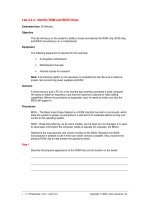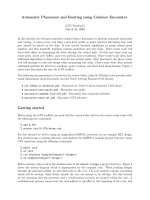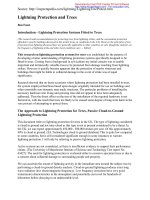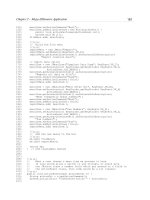Tài liệu 35 Wavelets and Filter Banks docx
Bạn đang xem bản rút gọn của tài liệu. Xem và tải ngay bản đầy đủ của tài liệu tại đây (163.28 KB, 16 trang )
Cormac Herley. “Wavelets and Filter Banks.”
2000 CRC Press LLC. <>.
WaveletsandFilterBanks
CormacHerley
HewlettPackardLaboratories
35.1FilterBanksandWavelets
DerivingContinuous-TimeBasesFromDiscrete-TimeOnes
•
Two-ChannelFilterBanksandWavelets
•
StructureofTwo-
ChannelFilterBanks
•
PuttingthePiecesTogether
References
35.1 FilterBanksandWavelets
Themethodsofdesigningbasesthatwewillemploydrawonideasfirstusedintheconstructionof
multiratefilterbanks.Theideaofsuchsystemsistotakeaninputsystemandsplititintosubsequences
usingbanksoffilters.Thissimplestcaseinvolvessplittingintojusttwopartsusingastructuresuch
asthatshowninFig.35.1.Thistechniquehasalonghistoryofuseintheareaofsubbandcoding:
firstofspeech[1,2]andmorerecentlyofimages[3,4].Infact,themostsuccessfulimagecoding
schemesarebasedonfilterbankexpansions[5,6,7].Recenttextsonthesubjectare[8,9,10].We
willconsideronlythetwo-channelcaseinthissection.If
ˆ
X(z)=X(z),thenthefilterbankhasthe
perfectreconstructionproperty.
FIGURE35.1:Maximallydecimatedtwo-channelmultiratefilterbank.
Itiseasilyshownthattheoutput
ˆ
X(z)oftheoverallanalysis/synthesissystemisgivenby:
ˆ
X(z)=
1
2
[G
0
(z)G
1
(z)]
H
0
(z)ψH
0
(−z)
H
1
(z)ψH
1
(−z)
X(z)
X(−z)
(35.1)
=
1
2
[H
0
(z)G
0
(z)+H
1
(z)G
1
(z)]·X(z)
c
1999byCRCPressLLC
+
1
2
[H
0
(−z)G
0
(z) + H
1
(−z)G
1
(z)]·X(−z).
Call the above 2 × 2 matrix H
m
(z). This gives that the unique choice for the synthesis filters is
G
0
(z)
G
1
(z)
=
H
0
(z) H
0
(−z)
H
1
(z) H
1
(−z)
−1
·
2
0
=
2
m
(z)
H
1
(−z)
−H
0
(−z)
,
(35.2)
where
m
(z) = det H
m
(z).
Ifweobservethat
m
(z) =−
m
(−z)anddefine P(z)= 2·H
0
(z)H
1
(−z)/
m
(z) = H
0
(z)G
0
(z),
it follows from (35.2) that G
1
(z)H
1
(z) = 2 · H
1
(z)H
0
(−z)/
m
(−z) = P(−z). We can then write
that the necessary and sufficient condition for perfect reconstruction (35.1) is:
P(z)+ P(−z) = 2.
(35.3)
Since this condition plays an important role in what follows, we will refer to any function having this
property as valid. The implication of this property is that all but one of the even-indexed coefficients
of P(z)are zero. That is
P(z)+ P(−z) =
n
(p(n)z
−n
+ p(n)(−z)
−n
)
=
n
2 · p(2n)z
−(2n+1)
.
For this to satisfy (35.3) requires p(2n) = δ
n
; thus, one of the polyphase components of P(z)must
be the unit sample. By polyphase components we mean the set of even-indexed samples, and the set
of the odd-indexed samples. Such a function is illustrated in Fig. 35.2(a).
FIGURE 35.2: Zeros of the correlation functions. (a) Autocorrelation H
0
(−z)H
0
(z
−1
). (b) Cross-
correlation H
0
(−z)H
1
(z
−1
).
Constructing such a function is not difficult. In general, however, we will wish to impose additional
constraints on the filter banks. So, P(z)will have to satisfy other constraints in addition to (35.3).
Observe that as a consequence of (35.2) G
0
(z)H
1
(z), i.e., the cross-correlation of g
1
(n) and the
time-reversed filter h
0
(−n), and G
1
(z)H
0
(z), the cross-correlation of g
1
(n) and h
0
(−n), have only
odd-indexed coefficients, just as for the function in Fig. 35.2(b), that is:
<g
0
(n), h
1
(2k − n) > = 0,
(35.4)
c
1999 by CRC Press LLC
<g
1
(n), h
0
(2k − n) > = 0,
(35.5)
(note the time reversal in the inner product). Define now the matrix H
0
as
H
0
=
.
.
.
.
.
.
.
.
.
.
.
.
.
.
.
.
.
.
.
.
.
.
.
.
h
0
(L − 1)h
0
(L − 2) ··· ··· h
0
(0) 00
00h
0
(L − 1) ··· h
0
(2)h
0
(1)h
0
(0)
.
.
.
.
.
.
.
.
.
.
.
.
.
.
.
.
.
.
.
.
.
.
.
.
.
(35.6)
which has as its kth row the elements of the sequence h
0
(2k− n). Pre-multiplying by H
0
corresponds
to filtering by H
0
(z) followed by subsampling by a factor of 2. Also define
G
T
0
=
.
.
.
.
.
.
.
.
.
.
.
.
.
.
.
.
.
.
.
.
.
.
.
.
g
0
(0)g
0
(1) ··· ··· g
0
(L − 1) 00
00g
0
(0) ··· g
0
(L − 3)g
0
(L − 2)g
0
(L − 1)
.
.
.
.
.
.
.
.
.
.
.
.
.
.
.
.
.
.
.
.
.
.
.
.
,
(35.7)
so G
0
has as its kth column the elements of the sequence g
0
(n − 2k). Define H
1
by replacing the
coefficients of h
0
(n) with those of h
1
(n) in (35.6) and G
1
by replacing the coefficients of g
0
(n) with
those of g
1
(n) in (35.7).
We find that (35.4) gives that all rows of H
1
are orthogonal to all columns of G
0
. Similarly we find,
from (35.5), that all of the columns of G
1
are orthogonal to the rows of H
0
. So, in matrix notation:
H
0
G
1
= 0 = H
1
G
0
.
(35.8)
Now P(z) = G
0
(z)H
0
(z) = z
−1
H
0
(z)H
1
(−z) and P(−z) = G
1
(z)H
1
(z) are both valid and
have the form given in Fig. 35.2 (a). Hence, the impulse responses of g
i
(n) and h
i
(n) are orthogonal
with respect to even shifts
<g
i
(n), h
i
(2l − n) > = δ
l
.
(35.9)
In operator notation:
H
0
G
0
= I = H
1
G
1
.
(35.10)
Sincewehaveaperfectreconstructionsystemweget:
G
0
H
0
+ G
1
H
1
= I.
(35.11)
Of course (35.11) indicates that no nonzero vector can lie in the column nullspaces of both G
0
and
G
1
. Note that (35.10) implies that G
0
H
0
and G
1
H
1
are each projections (since G
i
H
i
G
i
H
i
= G
i
H
i
).
They project onto subspaces which are not, in general, orthogonal (since the operators are not self-
adjoint). Because of (35.4), (35.5), and (35.9) the analysis/synthesis system is termed biorthogonal.
If we interleave the rows of H
0
and H
1
, much as was done in the orthogonal case, and form again a
block Toeplitz matrix
A =
.
.
.
.
.
.
.
.
.
.
.
.
.
.
.
.
.
.
.
.
.
.
.
.
h
0
(L − 1)h
0
(L − 2) ··· ··· h
0
(0) 00
h
1
(L − 1)h
1
(L − 2) ··· ··· h
1
(0) 00
00h
0
(L − 1) ··· h
0
(2)h
0
(1)h
0
(0)
00h
1
(L − 1) ··· h
1
(2)h
1
(1)h
1
(0)
.
.
.
.
.
.
.
.
.
.
.
.
.
.
.
.
.
.
.
.
.
.
.
.
,
(35.12)
c
1999 by CRC Press LLC
we find that the rows of A form a basis for l
2
(Z).IfweformB by interleaving the columns of G
0
and
G
1
,wefind
B · A = I.
In the special case where we have a unitary solution, one finds: G
0
= H
T
0
and G
1
= H
T
1
, and
(35.8) gives that we have projections onto subspaces which are mutually orthogonal. The system
then simplifies to the orthogonal case, where B = A
−1
= A
T
.
A point that we wish to emphasize is that in the conditions for perfect reconstruction, (35.2) and
(35.3), the filters H
0
(z) and G
0
(z) are related via their product P(z). It is the choice of the function
P(z)and the factorization taken that determines the properties of the filter bank. We conclude the
introduction with a proposition that sums up the foregoing.
PROPOSITION35.1
To design a two-channel perfect reconstruction filter bank, it is necessary and
sufficient to find a P(z)satisfying (35.3), factor it P(z)= G
0
(z)H
0
(z) and assign the filters as given
in (35.2).
35.1.1 Deriving Continuous-Time Bases From Discrete-Time Ones
We have seen that the construction of bases from discrete-time signals can be accomplished easily
by using a perfect reconstruction filter bank as the basic building block. This gives us bases that
have a certain structure, and for which the analysis and synthesis can be efficiently performed. The
design of bases for continuous-time signals appears more difficult. However, it works out that we
can mimic many of the ideas used in the discrete-time case, when we go about the construction of
continuous-time bases.
In fact, there is a very close correspondence between the discrete-time bases generated by two-
channel filter banks, and dyadic wavelet bases. These are continuous-time bases formed by the
stretches and translates of a single function, where the stretches are integer powers of two:
{ψ
jk
(x) = 2
−j/2
ψ(2
−j
x − k), j, k,∈ Z}
(35.13)
This relation has been thoroughly explored in [11, 12].
To be precise, a basis of the form in (35.13) necessarily implies the existence of an underlying
two-channel filter bank. Conversely, a two-channel filter bank can be used to generate a basis as in
(35.13) provided that the lowpass filter H
0
(z) is regular. It is not our intention to go into the details
of this connection, but the generation of wavelets from filter banks goes briefly as follows:
Considering the logarithmic tree of discrete-time filters in Fig. 35.3, one notices that the lower
branch is a cascade of filters H
0
(z) followed by subsampling by 2. It is easily shown [12], that the
cascade of i blocks of filtering operations, followed by subsampling by 2, is equivalent to a filter
H
(i)
0
(z) with z-transform:
H
(i)
0
(z) =
i−1
l=0
H
0
(z
2
l
), i = 1, 2···,
(35.14)
followed by subsampling by 2
i
. We define H
(0)
0
(z) = 1 to initialize the recursion. Now, in addition
to the discrete-time filter, consider the function f
(i)
(x) which is piecewise constant on intervals of
length 1/2
i
, and equal to:
f
(i)
(x) = 2
i/2
· h
(i)
0
(n), n/2
i
≤ x<(n+ 1)/2
i
.
(35.15)
Note that the normalization by 2
i/2
ensures that if
(h
(i)
0
(n))
2
= 1 then
(f
(i)
(x))
2
dx = 1 as well.
Also, it can be checked that h
(i)
0
2
= 1 when h
(i−1)
0
2
= 1. The relation between the sequence
c
1999 by CRC Press LLC
H
(i)
0
(z) and the function f
(i)
(x) is clarified in Fig. 35.3, where the first three iterations of each is
shown for the simple case of a filter of length 4.
FIGURE 35.3: Iterations of the discrete-timefilter ( 35.14) and the continuous-time function ( 35.15)
for the case of a length-4 filter H
0
(z). The length of the filter H
(i)
0
(z) increases without bound, while
the function f
(i)
(x) actually has bounded support.
We are going to use the sequence of functions f
(i)
(x) to converge to the scaling function φ(x)of a
wavelet basis. Hence, a fundamental question is to find out whether and to what the function f
(i)
(x)
converges as i →∞. First assume that the filter H
0
(z) has a zero at the half sampling frequency,
or H
0
(e
jπ
) = 0. This together with the fact that the filter impulse response is orthogonal to its
even translates is equivalent to
h
0
(n) = H
0
(1) =
√
2. Define M
0
(z) = 1/
√
2 · H
0
(z), that is
M
0
(1) = 1.NowfactorM
0
(z) into its roots at π (there is at least one by assumption) and a remainder
polynomial K(z), in the following way:
M
0
(z) =[(1 + z
−1
)/2]
N
K(z).
Note that K(1) = 1 from the definitions. Now call B the supremum of |K(z)| on the unit circle:
B = sup
ω∈[0,2π]
|K(e
jω
)|.
Then the following result from [11] holds:
c
1999 by CRC Press LLC









